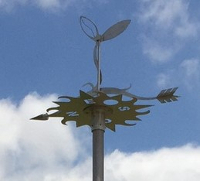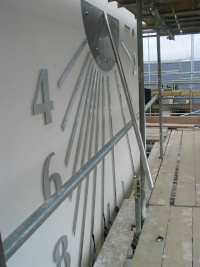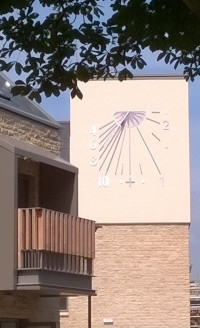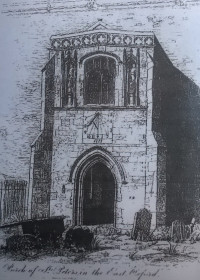Some ups and downs
of Lettering and Sundial Projects
David Brown
This article is based on a talk given at the British Sundial Society 2018 Newbury meeting. It was originally published in the Bulletins of the British Sundial Society 30 (iv), and we acknowledge permission to reprint it with thanks.
It might be thought that all projects in lettering and sundial-making proceed without a hitch. Often this is the case, but the reality is that not all do.
A carefully-cut numeral on a headstone I created some years ago which was later found to be wrong, resulted in a much larger area of stone and letters having to be rubbed down and the details re-cut.
The lesson? Check and check again before cutting!
Ingleby Farms and Forests, Peru

A polar sundial project for Ingleby Farms and Forests in Peru went well, but when I received a photo of the accompanying pole-mounted wind-vane (topped by the company logo) I could see that the sunburst carrying the cardinal points had been mounted upside-down. A few emails soon got that corrected.
Memo to self: send really clear instructions if the installation is to be done by other people.
Photo: Robin Begg
Steepleton Retirement Village, Gloucestershire
Some jobs need new techniques or materials to be worked out with our partners as we go along.

The architects of a new retirement village called Steepleton, in the suburbs of Tetbury in Gloucestershire, asked for a sundial on the otherwise blank wall of the proposed community centre.
The suggestion was that the details be moulded into the render. Positions for the hour lines would be marked by wood strips sunk into the render. However, achieving the correct match between the depth of the render and the wood strips proved to be problematic and it was decided that the hour lines and numerals would be better as surface-mounted components.

Stainless steel was rejected on the grounds of cost, so sign-makers’ plastic was used, ordered locally, with a brushed aluminium finish. These components were to be fixed with adhesive and some trial and error was required to find the product which would secure the components permanently to this particular surface.
The stainless steel sunburst and gnomon also had their challenges but I was able to complete the whole sundial this Spring (2018).
An Equation of Time plaque is mounted at eye level below the sundial.
St Edmund Hall Library, Oxford

Quite often meeting a deadline means that I spend a lot of time in the workshop in the days before a promised delivery date. Sometimes the reverse is true, if installation has to wait for other bits of the jigsaw to fall into place, final approvals given, funds raised or even hoped for favourable weather.
A sundial for the library of St Edmund Hall, Oxford, is a project that was begun in 2009, and, at the time of writing, still not brought to fruition.
The library occupies the deconsecrated church of St Peter-in-the-East which is adjacent to the Hall. A former Bursar had discovered a print showing a sundial dated 1777 over the porch of the south door, the only existing trace of which is outline markings on the stone; and he set in motion the process of replacing it.

In this case, personnel have changed during the intervening years, and the installation has to be harmonised with the rhythm of the academic year and planned building and maintenance work. The sundial has been made, and we are still waiting for the stars to align so that it can be lifted into place.
The story will need to be told in full at a later date.
